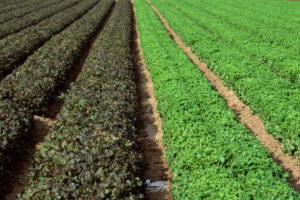New Multi-State Outbreak of E. coli Likely Linked to Romaine Lettuce…Again.

We now have another E. coli outbreak, first identified in Wisconsin, of this same type of bacteria. It has since been found in other states and initial testing of products in Maryland indicate that it is likely, once again, contaminated romaine lettuce that is to blame. In this case investigators found E. coli O157:H7 in a package of ‘Ready Pac Bistro® Chicken Caesar Salad’. They have also linked a total of 17 related cases so far in 8 different states. Most of those states, including Wisconsin which has 6 linked cases, do not sell ‘Ready Pac’ products, so we know the contaminated ingredient is likely in multiple products and is certainly widespread.
“We need the investigators at the CDC, FDA and state health departments to complete matching the genetic fingerprints in this outbreak and trace the contaminated products to their source. Victims of E. coli poisoning deserve to know what made them so sick.”
-Fred Pritzker, food safety attorney at the Pritzker Hageman law firm
How Do Investigators Try to Figure Out Where E. coli Contamination is Coming From?
When investigators work to figure out if people who have been sickened by E. coli were sickened from the same source, they start by determining if infected people consumed the same product, products containing the same ingredients or products that all came from the same place. This is called epidemiological evidence. Scientists then can use “genetic fingerprinting” to determine if the E. coli infecting one person came from the same source as the E. coli infecting another person. If they have a sample of contaminated product, they can then determine if the E. coli on that product is also from the same source. Investigators in Maryland used an extremely accurate form of this fingerprinting technique called Whole Genome Sequencing (WGS) to initially tie people infected with E. coli to one another and to the ‘Ready Pac’ product. Scientists in all the other states are using this or similar techniques, along with the epidemiological evidence, to try and match everyone in this outbreak to each other and to the products they have consumed. They can even use the degree of the genetic match to determine not just whether a product or victim matches, but how closely they match. This can provide information on the extent of the contamination and whether the contamination is related to other outbreaks in the past.
Why Haven’t They Been Able to Find the Source of E. coli Contamination in this Outbreak Yet?
So, if all of these investigators are putting together all of these clues…and if producers and supplier are supposed to be keeping track of where the lettuce they sell comes from…why don’t we know who the growers and suppliers of the lettuce are? Why haven’t the efforts of the investigators allowed them to find the source of the contamination (something the scientists call “traceback”)?
It’s hard enough and rare enough that investigators are able to find actual contaminated product – with an incubation time of 3-4 days before symptoms occur, contaminated products are often consumed or discarded by the time someone thinks to check them for contamination, and in a single bag of lettuce only a few pieces might be contaminated and consumed while the rest of the unused pieces are fine – so when they do have an actual positive sample of the product it should be a slam-dunk to trace the product back through the supply chain to the farm that grew it. Right? But in this outbreak, once again, they haven’t been able to. The best they have been able to do so far is to say it may have come from somewhere in California. Possibly, but not certainly, from the Salinas region. They will continue to work hard to try and pinpoint it further, but this may be the best they are able to do because the growers, suppliers and vendors have not implemented the tracking processes and technologies that were recommended after the last outbreak. This means that by the time the lettuce is in the bag it has moved between multiple transporters, suppliers, and vendors and may have been mixed with lettuce from farms all over the current growing regions. And so, once again, we are left, at least so far, not knowing how and where manure is getting onto our fresh vegetables resulting in people all over the country, who believe they are eating what should be healthy food, to fall victim to E. coli poisoning.
“The producers and suppliers of romaine lettuce and other produce need to get their act together and start tracking where their products come from and where they end up. Until they do, we’ll continue to get products contaminated with fecal matter, and we’ll see plenty more E. coli outbreaks in the future.”
-Fred Pritzker